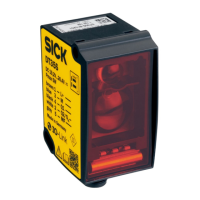•
Approach speed of the objects
•
Resolution (detection capability) of the device
•
Type of approach
•
Parameters specified based on the application
•
Supplements for general and, possibly, reflection-based measurement errors
The calculation of the minimum distances and the associated verification must be
performed by the system integrator on an application-specific basis.
9.8
Use in the safety-related system
The device contains functions that can be used in a higher-level system to detect errors
or to assess the quality of the measurement data. The associated information can thus
be used to improve decision-making at the system level (e.g., as part of the controller
evaluation). It is also possible in this way to implement a higher safety integrity at the
system level.
9.8.1 Measures to improve the diagnostic coverage
Diagnostic options can be used to increase the device availability or to integrate the
device into systems with more stringent requirements on functional safety.
A distinction is made between internal and external diagnostics.
Internal diagnostics are performed online by the device and put the safety-related
outputs in an error state that requests the safety function performed by the device (the
system changes to the safe state).
External diagnostics require an evaluation of the system, e.g., of the expected values
from the project planning, with the device providing information for this purpose. Based
on this information, decisions can then be made to increase the device availability or
safety, and actions or decisions can be triggered in the system.
9.8.1.1 Clamp alarm function
The device measures the amount of reflected light and can use it to make a prediction
about the reliability of the measurement. If the device is intended to be used in an
application where one or more targets are constantly present in the measurement area,
this internal diagnostic can be used to diagnose the measurement capability of the
system.
To use the internal diagnostics, the alarm function parameter must be set to “Clamp”.
The alarm value (see "Alarm function - clamp", page 20)will then be assumed at all
safety-related interfaces if the measuring capability is too low.
The diagnostics relate to the optical measuring path and can detect associated internal
and external errors.
9.8.1.2 Digital output alarm function
For diagnostic purposes, the alarm parameter can be set for the switching function.
This places the result of the internal diagnostics test at the assigned digital output.
The output is switched active when the alarm condition is met. The status of the alarm
output can also be displayed via the status bits in the IO-Link process data.
The diagnostics relate to the optical measuring path and can detect associated internal
and external errors.
PROJECT PLANNING 9
8027663//2022-08-04 | SICK O P E R A T I N G I N S T R U C T I O N S | DT35S
51
Subject to change without notice

